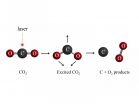(Press-News.org) A team of researchers from the Massachusetts Institute of Technology (MIT) in Cambridge, MA have demonstrated a novel automated fabrication process consisting of a three-step sol-gel extrusion, structure freezing and drying, and mechanical drawing process which results in production of highly aligned polymer films. Alignment of molecular chains within polymers is a desirable trait for many applications as it results in superior mechanical and thermal properties in the polymeric materials. Although these highly aligned polymer films (HAPFs) are in demand, previous fabrication methods were limited to manual, lab-scale batch processes. This novel, scalable technology can enable deployment of low-cost and energy efficient polymer alternatives to traditionally used materials in heat transfer applications, such as electronic packaging and heat exchangers, with the additional advantages of energy savings, weight reduction, chemical resistance, and electrical insulation. The report appears in the September 2014 issue of the journal Technology.
"By taking advantage of the inherent high thermal conductivity of polymers' C-C bond, and a corresponding reduction in chain entanglements and defects, this process opens the door for transforming materials which are traditionally considered thermal insulators into something that is ideal for use in heat transfer applications," says Professor Gang Chen, Ph.D., of the Massachusetts Institute of Technology and Principal Investigator on the paper.
While lab-scale fabrication processes have been successfully demonstrated, however, the investigators at MIT were able to solve the significant challenges which exist in terms of scaling and automated handling of the numerous process variables. In this work, improvement, or 'tuning' of the material properties, is achieved through manipulating the polymers' molecular chains first by disentanglement followed by macroscopic plastic deformation-induced alignment. This high throughput platform has three advantages over previous methods: (1) utilization of Couette flow for enhanced chain disentanglement; (2) constant-force adaptive-thickness mechanical drawing system aiding in uniform film production; and (3) an automated scalable platform - thus successfully demonstrating a desktop printer sized fabrication platform for HAPFs in a commercially attractive form factor.
Utilization of Couette flow produces a high degree of molecular chain disentanglement; liquid N2 cooling freezes the disentangled structure in the extruded polymer gel; and the constant-force mechanical drawing leads to highly crystalline and uniform aligned final films. The platform was demonstrated using ultra-high molecular weight polyethylene, producing HAPFs with crystallinity >99% and lengths exceeding 15 meters. Molecular chain disentanglement has two crucial effects: (1) allows for plastic deformation to high draw ratios without film rupture, and (2) helps in subsequent molecular chain alignment for improved material properties.
While commercial-grade production systems for highly aligned polymer fibers are already in use (and address an existing mature commercial market), new opportunities for highly aligned polymers in a film form factor must be addressed. "This is a great example of a market-ready technology, which can supplement existing fabrication processes used for producing aligned polymer fibers. While fibers are ideal for textiles, however, for practical applications, such as fins in heat exchangers, casings for electronic systems, and biomedical treatments for improved cooling, a film (vice fibrous) form of these materials is essential.
The difficulty lies in translating the remarkable material property enhancements seen in high performance fibers into a film form factor," says James Loomis, Ph.D., the lead author on this paper. "Furthermore, for widespread commercial implementation of these advanced materials, a scalable, continuous, and robust film manufacturing platform is needed."
The team from MIT is working now to further characterize structural changes in the polymers as a function of the draw ratio (amount of plastic deformation in the films), establishing relationships between varying molecular weights and realized material properties, and investigating orientation effects of highly aligned nanocarbon-polymer composites. Application of this technology towards composites which incorporate electrically conductive nanofillers presents an exciting new direction for commercial deployment of composites with tunable strength, and thermal conductivity, and electrical conductivity.
INFORMATION:
Additional co-authors of the Technology paper are Hadi Ghasemi, Ph.D., Xiaopeng Huang, Ph.D., Nagarajan Thoppey, Ph.D., Jianjian Wang, Jonathan K. Tong, Yanfei Xu, Ph.D., Xiaobo Li, Ph.D., and Cheng Te Lin, Ph.D., all from the NanoEngineering Group at the Massachusetts Institute of Technology.
This work was funded by the Department of Energy/Office of Energy Efficiency & Renewable Energy/Advanced Manufacturing Program (DOE/EEREAMO) under award number DE-EE0005756.
Corresponding author for this study in Technology is Professor Gang Chen, Ph.D., gchen2@mit.edu.
When you take a shower and rinse the soap and shampoo off your body, the foam conveniently disappears between your toes and down the drain. Have you ever thought about what happens to the surfactants afterwards? Whether they seep into the groundwater, lakes and streams, where they could pose a risk to fish and frogs?
Not likely. This is shown in a new and very comprehensive report of the potential impact on the environment of the enormous amounts of common surfactants used day in and day out by consumers all over the world.
"We humans use several million tons of ...
Microfluidic tools for precision measurements of cell migration speed reveal that migratory speed of individual cells changes stochastically from parent cells to their descendants, while the average speed of the cell population remains constant through successive generations.
A team of researchers at the Massachusetts General Hospital and Harvard Medical School in Boston has developed technologies for precision measurement of cell migration speed before and applied the new tool to study the variations of migration speed in population of cancer cells. This tool enabled ...
Scientists at the University of Granada, in collaboration with La Paz University Hospital in Madrid and the University of Texas, San Antonio in the US have demonstrated through several experiments conducted on Zucker obese rats that chronic consumption of melatonine helps combat obesity and diabetes mellitus type two.
Their research has confirmed that chronic administration of melatonine in young obese rats with diabetes mellitus type two, similar to its human equivalent, improves mitochondrial dysfunction (i.e. mitochondrial homeostatic functions) in a very efficient ...
Social network analysis could improve knowledge sharing in the healthcare sector, according to research results published in the International Journal of Collaborative Enterprise.
Elizabeth Cudney, Steven Corns and Suzanna Long in the department of Engineering Management and Systems Engineering at Missouri University of Science and Technology, in Rolla, Missouri, USA, explain how knowledge management systems (KMS) can be critical in capturing, retaining and communicating project results and staff knowledge. They can prevent knowledge drain and provide training as "lessons ...
Researchers at the University of Granada have designed a new imaging system capable of obtaining up to twelve times more colour information than the human eye and conventional cameras, which implies a total of 36 colour channels. This important scientific development will facilitate the easy capture of multispectral images in real time, and in the not too distant future it could also be used to develop new asisted vehicle driving systems, identify counterfeit bills and documents or obtain medical images much more accurate than current ones, among many other applications.
The ...
Many of those who are genetically predisposed to develop atrial fibrillation, which dramatically raises the risk of stroke, can be identified with a blood test. This is shown by new research from Lund University in Sweden.
The number of people affected by atrial fibrillation is rising rapidly, partly as a result of the ageing population.
Over recent years, a research group at Lund University in Sweden, working with other universities and hospitals in Europe and the USA, has identified twelve genetic variants in the human genome that increase the risk of atrial fibrillation. ...
Johnny Depp has an unforgettable face. Tony Angelotti, his stunt double in "Pirates of the Caribbean," does not. So why is it that when they're swashbuckling on screen, audiences worldwide see them both as the same person? Scientists from the University of California, Berkeley, have cracked that mystery.
Researchers have pinpointed the brain mechanism by which we latch on to a particular face even when it changes. While it may seem as though our brain is tricking us into morphing, say, an actor with his stunt double, this "perceptual pull" is actually a survival mechanism, ...
yphoon Phanfone's eye appeared the size of a pinhole on visible imagery from NASA's Aqua satellite on Oct.3.
The MODIS instrument or Moderate Resolution Imaging Spectroradiometer that flies aboard NASA's Aqua satellite captured a visible image of Phanfone moving through the Northwestern Pacific Ocean on Oct. 3 at 4:20 UTC (12:20 a.m. EDT). The tiny open eye of the storm was surrounded by a thick band of thunderstorms. The MODIS image also showed a very thick and large band of thunderstorms south of the center and spiraling into the eye.
On Thursday, Oct. 2, Typhoon ...
VIDEO:
Mexico's western coast is again dealing with rain, wind and rough surf from another tropical storm. NOAA's GOES-West satellite saw the formation of Tropical Storm Simon on Oct. 2. A...
Click here for more information.
Mexico's western coast is again dealing with rain, wind and rough surf from another tropical storm. NOAA's GOES-West satellite saw the formation of Tropical Storm Simon on Oct. 2. A NASA animation of NOAA's GOES-West satellite imagery shows the development ...
About one-fifth of the Earth's atmosphere is oxygen, pumped out by green plants as a result of photosynthesis and used by most living things on the planet to keep our metabolisms running. But before the first photosynthesizing organisms appeared about 2.4 billion years ago, the atmosphere likely contained mostly carbon dioxide, as is the case today on Mars and Venus.
Over the past 40 years, researchers have thought that there must have been a small amount of oxygen in the early atmosphere. Where did this abiotic ("non-life") oxygen come from? Oxygen reacts quite aggressively ...







